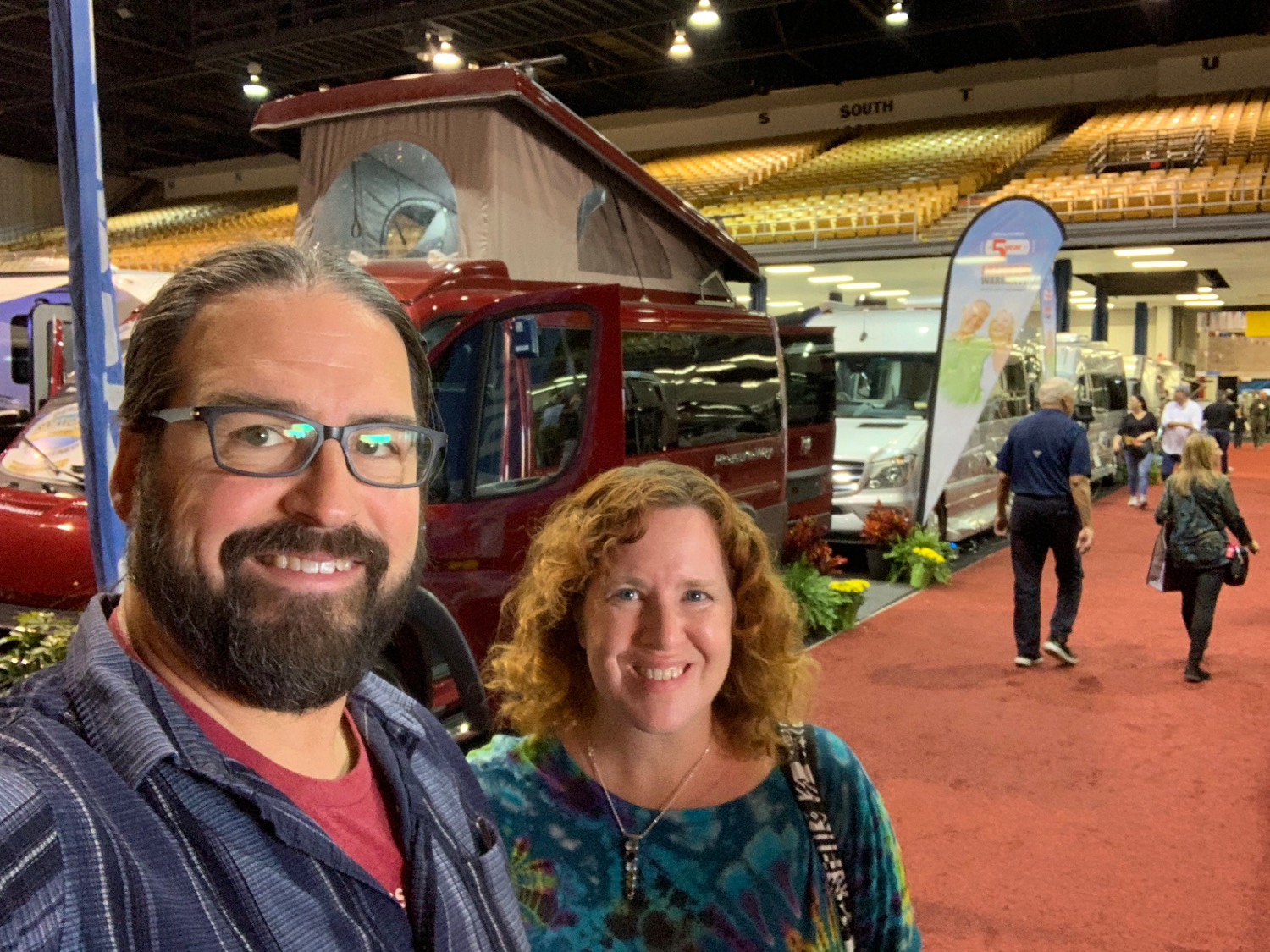
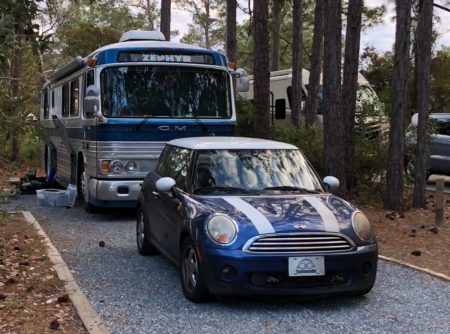
First off – lets answer the obvious questions…
NO – we are not looking to sell or replace our vintage bus conversion Zephyr.
Nor are we looking to give up on boat life aboard Y-Not!
We still love the idea of spending roughly half the year on the water cruising in our boat, and half on land enjoying desert boondocking and extended explorations in our bus.
And as we move the boat further north, winters will be a chilly incentive to get us off the water and out RVing more months each year.
The catch – the boat will be perpetually on the east coast, and our plan is for the bus to be spending most of its time in the desert southwest – with its “home base” storage location in Benson, AZ on our co-op lot.
And while our Mini Cooper is a great RV toad and marina get-around vehicle – it is NOT comfortable for cross country road trips and relocations, especially when loaded down with cargo and a cat.
We need a better way to move back and forth between our two primary homes.
We crave a better teleportation pod. But what?
First Thought – Replace The Mini???
Our Mini Cooper is getting old and is having increasing issues, and it is the absolute base model lacking in even basics like cruise control. Because of this – we’ve been idly thinking about replacing our Mini Cooper as our toad for the past year or so.
However our bus was never designed to tow something behind it, and there aren’t even any official specs on what the safe towing capacity might be.
We feel good towing something small and light, but we don’t want to push it much beyond the size of a Mini or a small Jeep.
And anything we tow behind the bus will age rapidly living so close to the exhaust of a big Detroit Diesel engine. At least rust would never be a concern, thanks to the perpetual fine mist of oil.

Every time we’d start down the path of hunting for a Mini replacement, we’d give up. There just wasn’t a vehicle that we could find that would be a comfortable cross-country traveler, that was light enough to tow, and which was affordable enough to justify both the wear & tear and our limited use.
But…
What if we gave up on the requirement that our Mini replacement has to be flat towable?
Our future RV travel plans aren’t likely to involve huge driving days, so perhaps traveling in a convoy together would work. I’d drive the bus, and Cherie could scout ahead or follow behind in our smaller vehicle.
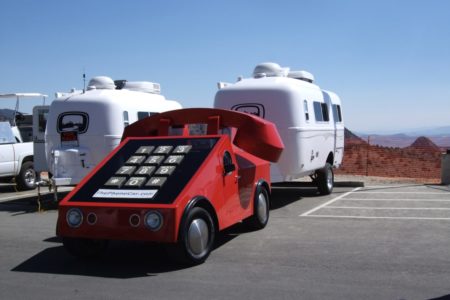
Thinking this way changed everything – we could consider all sorts of options now. A Prius, or even a Tesla!
But even if we had a Tesla capable of cruising across the country on semi-autopilot, we’d still be hotel-hopping with a cat whenever we crossed country.
And cannonballing across the country twice a year just wouldn’t be that much fun if we felt forced to do it at such a fast pace.
And with our parents living in Florida, we’re always going to want to combine a trip south from the boat first to spend time with them before heading west anyway – complicating our road trip plans even further.
We’d much rather travel at a slower pace, maybe spending two or three weeks really enjoying and exploring during each seasonal relocation.
And that’s where the thought of replacing the Mini with a small RV was born.
As crazy as it seemed at first, it just started to feel logical.
What if we could find something small enough to use as our east coast errand car, hop-scotching up the coast with the boat giving us a way to locally explore and provision the way we use the Mini Cooper now.
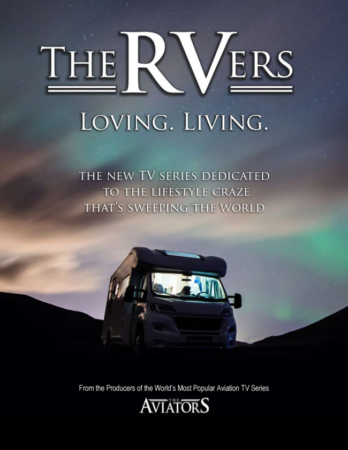
And since we’re slowing down our boat travels with lots of monthly stays, that would give us the opportunity to explore further inland for short camping trips, attend RV events and do more extensive mobile internet gear testing for our work life over at the Mobile Internet Resource Center.
And having ready access to an RV would sure make filming our segments for the upcoming The RVers TV show a heck of a lot easier than trying to juggle rentals and/or borrowing RVs!
And when it comes time to head west, an RV would be a comfortable teleportation pod – big enough to enjoy traveling cross-country in without needing to worry about hotels. We could stay in the parks we love along the way, driveway surf with friends & family, and even blacktop boondock in parking lots when needed.
And when out west, we’d also have a nimble RV for exploring places our bus can’t go.
The more we thought about it, the more we thought….
Why not? (Or is that Y-Not?)
Why not ditch our Mini Cooper, and go with a class B van as our daily driver?
We went to the Tampa RV Super Show this week to start our hunt, and here is our video we made there:
Teleportation Pod Camper Van Requirements
Parking spots in the United States tend to be between 7.5′ and 9′ wide, and 16′ to 20′ long.
We need something that can fit into the sort of parking spots we’ll find at east coast marinas, which means focusing our search on Class-B camper van RV’s that are under 20′ long – though (perhaps) a little bit of overhang might prove to be OK.
We also need something that is easy and fun to drive & park, even in cities.
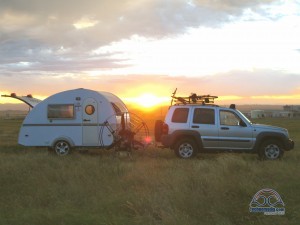
This probably rules out anything that is large or a wide-body. There are a LOT of 25′ long extended vans, and B+ campers that are absolutely amazing in relatively small spaces – but these would all probably be too big for our needs.
Besides – we aren’t looking for something to full-time in. We just need something suitable for a couple extended cross country road trips and some long weekends each year.
Here are some of the features we are looking for in our ideal teleportation pod:
- Small & Nimble – Obviously this is key. Whatever we get needs to be a great cross-country cruising vehicle, and comfortable as a daily driver – driving both around town and down the interstate.
- Comfortable Bed – Some of the options we have looked at seem to really skimp in this regard. We’d prefer to not be sleeping on what is essentially a folding bench seat. And we prefer a ‘real’ full or queen size bed for snuggling. Unfortunately, convertible beds are quite common in van conversions – as it is a great way to maximize the space.
- Pet Friendly Power System & AC – We want to be able to leave Kiki home while we are out playing, which might mean needing AC to keep her cool. An auto-start generator and/or a smart lithium power system that can keep a cat cool without needing to run a generator non-stop is ideal – and it is cool to see these sorts of advanced systems finally becoming a bit more common.
- Smartly Designed Living Space – We want space for us both to be able to sit and work on our laptops for a couple hours at a time without feeling stuck deep in a cave. We want good ventilation, and screens that let the space feel open while keeping the cat in and the bugs out. And at night, we want privacy and blackout shades. We want a kitchen & bath that is usable, but we don’t necessarily need anything overly posh there.
-
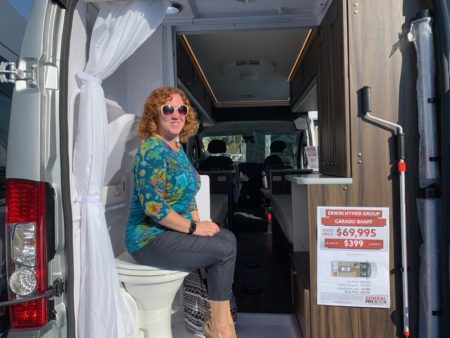
Several Class-B floorpans devote the entire rear to the bathroom. We’d prefer to open our rear doors and see.. oh.. nature, not our toilet. But… a Place to Poop Privately – We expect we will rarely want to shower in the van, but we will need a bathroom for other purposes. Having facilities that do not take up too much space, and which can be used without putting on a show is ideal. Some vans we saw had toilets that could only be used with the doors open to the rest of the living area – not our style. Other designs we’ve seen leave out a private bathroom entirely and replace it with a portable potti – been there, done that during our first year in the T@b. Nope. We also need a place for Kiki’s litter box too…
- Quality Build & Good Support – It is no secret that a lot of RVs are poorly built – with very little attention put into design, materials, craftsmanship, or overall build quality. We want to buy something that is built to last, and which will hold its value.
- Geeky & Cool – We are Technomadia after all. The more cutting edge technology we can get, the better. Unfortunately, the latest tech comes in newer models with a heftier price tag. We may need to compromise here and/or plan to do some upgrades on our own later.
- Available – We’d ideally want something we can get our hands on this spring or summer – patience is not one of our virtues once we’ve made up our minds. Our next cross country trip back to the bus could be as early as this summer or next fall. A lot of Class-B manufacturers, especially custom builders, seem to have backlogs over a year long – which rules them out for us unless we somehow get lucky or find something used.
- Affordable – The thought of paying more for a van than we paid for our boat really hurts our heads. We don’t mind paying for quality, but we will be seeking out either an exceptional deal on something new or a well loved used model.
There are a lot of other options that are nice to have, but some aren’t so critical for our needs.
For example – a 4×4 van would be nice, and the Sprinter 4×4 chassis is pretty sweet. But for our intended uses, it is probably overkill and not worth the cost – or the seemingly long wait required to get a rare 4×4 Sprinter chassis.
Ample solar would also be nice – but on a vehicle the size of a van it would be hard to get enough solar to be truly autonomous. And it’s not like we’re setting up to full time or boondock lots – that is what our bus is for. So we’d be fine with just a token amount to keep the batteries topped off while parked.
We also love induction cooking – and prefer compressor fridges to propane. But if we have to go with a propane-centric system, as long as it is smartly designed that is OK.
Diesel or Gas?
Though some people have very strong feelings on this issue – we honestly do not have a preference.
Gas engines tend to be cheaper up front, but slightly less fuel efficient. On the other hand – currently diesel costs more than gas eliminating any savings from that efficiency.
Diesel engines also tend to cost more to service, but they have a longer overall expected lifetime.
With our planned usage – either type of engine could work. We’re more concerned with how well it drives and the overall ergonomics than what kind of fuel we need.
The Hunt Begins: Our Initial Contenders
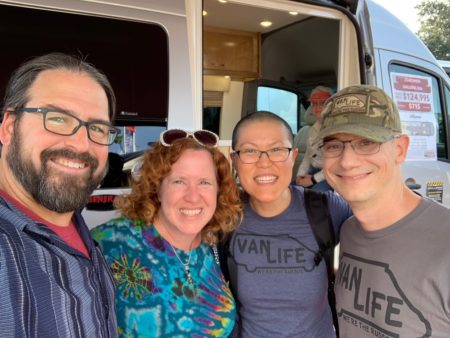
There are a LOT of companies that make class B RV’s – and our friends Joe & Kait Russo keep up a comprehensive list of manufacturers (currently 25 listed!) that is the best go-to resource we have found.
All of these manufacturers start with a standard van chassis, such as a Mercedes Sprinter, Dodge Promaster, or Ford Transit – so in some ways there is a lot in common up front.
But the customizations that turn a bare van into an RV make all the differences in the world.
Some are mass produced, others are custom designed and made to order, and many are semi-custom with only limited options available.
Some converters even allow (or require!) you to purchase a new or used van on your own, and then you hand it over for transformation.
We’ve only just begun to research options, but here is what on our radar so far – and some initial thoughts.
Under 20′ Options:
There are not a lot of options that are under 20′ long, which is required to comfortably fit into many parking spots.
It takes a lot of smart design to fit all the necessities into a space this small.
- Airstream Interstate Nineteen – Airstream’s only small Class-B is 19′ long and based on a Sprinter chassis. We toured this and overall were not impressed – Airstream feels more focused on style than substance for our personal needs.
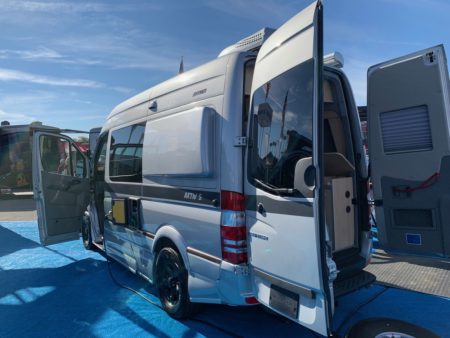
- Carado Banff & Axion – Carado has some interesting designs in a more affordable price bracket, but the floorplans all feature the toilet perched in the back door and split twin beds. We’re finding we much prefer a layout that keeps the bath not ‘in view’ when you want air flow from the back doors.
- Hymer Aktiv / Aktiv S – There is a lot to like about the 19’7″ Hymer Aktiv (based on the Roadmaster) or the new Sprinter-based Aktiv-S, and the slightly longer Aktiv 2.0 (20′ 9″) adds a bit more interior space too. These were actually the first vans that tempted us to consider this transporter-pod plan when we did some toe-dipping back in September – and we like Hymer’s EcoTrek lithium battery option and VoltStart generator start feature. But when we toured the Hymer RVs again at the Tampa RV Show we weren’t as impressed as the first time – and we noticed way too many fit-and-finish issues in the models on display. We also were not impressed with the awkward bed setup.
-
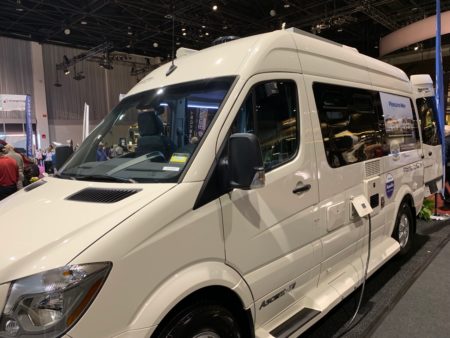
We were very impressed by the Pleasure Way Ascent TS – it is our favorite under 20′ option we have toured so far. Pleasure-Way Ascent TS – We were very impressed by the Pleasure-Way models we toured at the Tampa RV show, and really liked the quality vibe from the company after spending some time talking with the CEO Dean Rumpel. The Ascent is the smallest Pleasure-Way model, based on a Sprinter chassis. It comes with a 200Ah lithium system, solar, auto-generator start, and Pleasure-Way seems to have made a well balanced set of tradeoffs in putting this design together. But this level of quality comes at a price.
- Roadtrek Simplicity SRT – Though Roadtrek has a huge range of Class B models, the cheapest and simplest Roadtrek was one of the most reasonably priced options we saw at the Tampa RV Show. If we want to keep things basic – this is an option.
- Roadtrek SS Agile – Based on the short Sprinter, the Agile is a higher end model from Roadtrek with a lot of customization options – including an E-Trek package with 800Ah of lithium and 370W of solar. But we just were not blown away by the styling and interior feel when we toured it at the Tampa show – at least, not for the price point.
- Safari Condo – We have not seen any models from this Canadian converter in person, but they have some interesting looking designs ranging from 18′ to 22′ long. It isn’t clear how much of a presence this company has south of the border though.
- Sportsmobile – Sportsmobile has been doing van conversions since the 1960’s, and they offer every possible chassis and size you can imagine. Every Sportsmobile is made to order, and the number of options you can configure is very literally overwhelming. Used Sportsmobiles are rare, and most seem to hold their value. We have not yet had a chance to tour one in person, but are intrigued about looking into what used models might be available.
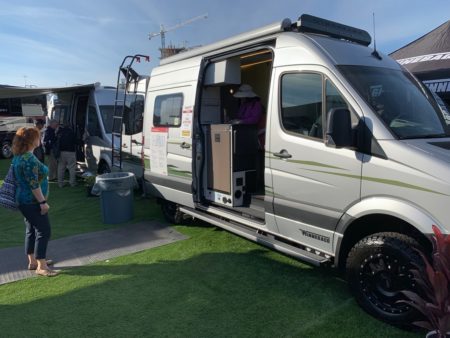
The new Winnebago Revel is made for adventure – but it is probably not ideal for us. - Winnebago Revel – The 4×4 Sprinter-based Winnebago Revel is really smartly designed, if you are looking for a hardcore adventure vehicle. But a few design tradeoffs make it a very poor fit for our needs – including the way the bathroom is a gear closet, the bed blocks the AC when raised, and storage for things other than mountain bikes and climbing gear is seemingly lacking. But we did like how the bed lowers, and would love to see more murphy/lowering bed options in vans in general.
PS: A special shoutout to the Roadtrek and Winnebago websites.
The Matterport-powered 3D virtual tours they feature are the best way we’ve seen to explore an RV short of visiting one in person, and they have done a great job letting you get in and poke around without actually being there.
We wish every RV manufacture offered virtual tours like this!
Slightly Larger:
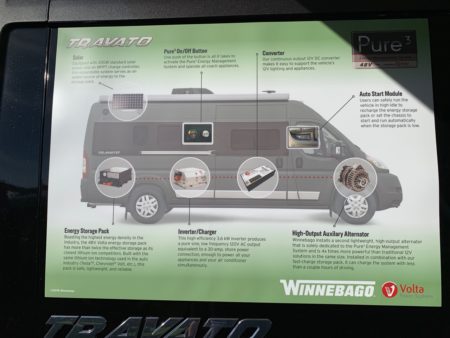
If we are open to a bit of overhang while parking, there are a lot more options…
- Advanced RV – Every Advanced RV is custom made on a Sprinter chassis, and they have a reputation for doing some amazing work with a LOT of thought put into well designed systems – including now even 48V Volta lithium. The smaller Advanced RV models are 22’9″ and the larger are 24’1″ – but other than size, the big catch with Advanced RV is the cost and the wait to get one.
- Coachman Crossfit – Based on the Ford Transit chassis, we somehow missed touring the 22’2″ Crossfit at the Tampa show. But our friend Kristin Snow last year traded in a Travato for one of these and she loves it and even uses it as her daily driver.
- Pleasure-Way Lexor TS – The 21′ Lexor models are slightly larger options from Pleasure-Way, built on the Dodge Promaster chassis. It also comes with a 200Ah lithium system. They have all of the features and build quality we appreciated in the Ascent model, and the price tag is a bit lower too thanks to using a gas instead of a diesel engine.
- Roadtrek E-Trek – Roadtrek’s flagship model is “designed for those with a passion for technology and the environment” and it has a lot of geeky goodness aboard its 22’9″ length – including 470W of solar and 800Ah of lithium and a propane-free design that relies on diesel for heat and hot water. Starting price – just $162,006!?!?
- Sportsmobile – See the section above. Sportsmobile does both large and small Class B’s.
-
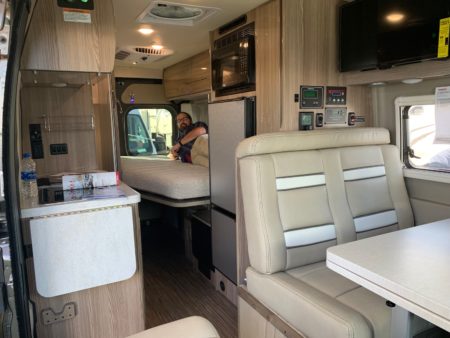
Trying out the bed in the back of a Winnebago Travato G, contemplating our future… Winnebago Travato – We were really impressed with the 21′ Winnebago Travato – especially the new 2019 59GL model which features a 48V lithium battery system from Volta Power Systems that eliminates the need for a generator and uses the engine alternator to charge on-demand when needed. The Travato also comes with 200W of solar standard, and seemed to have a lot of smart design elements throughout. We were far more impressed with the Travato than we thought we would be, and it has us seriously considering if going 21′ is practical.
We’ll have to consider very carefully whether the tradeoffs of going a bit larger are worth it – particularly since we aren’t intending to full-time in a van.
We’d love to hear how well larger class B’s have worked for others when put to use as daily drivers in urban environments, and particularly storing in marina (or similar) parking lots.
How big is too big?
Larger Still?
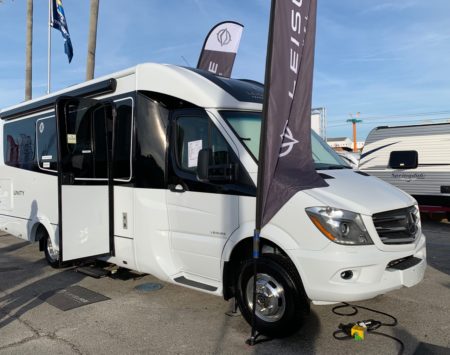
If we push up into the 24′ – 25′ range, there are a few very impressive options to be had when you look at extended length vans, and some that are technically considered B+ or small C campers that are wider as well as longer and which come with vastly more interior space.
In particular, at the Tampa RV Show we were VERY impressed with the design and overall quality of the Leisure Travel Vans we toured, and the Coach House models were also impressive too.
But if we went that big – that would be replacing Zephyr, not serving as a cross-country transporter and exploration pod.
And that’s just not our goal at the moment, nor is a larger motorhome practical as a daily driver or for marina hopping.
But, should the day come that we’re ready to be a one-RV family again and we decide the bus is too big for future adventures… our curiosity is piqued by these excellent designs.
Why Not DIY or Custom Build?
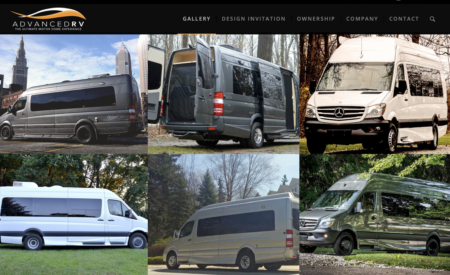
There are suppliers that provide kits to help people tackle converting a bare van shell into an RV on their own. And there are many who just convert raw shells on their own without kits.
While we love DIY projects, we don’t have the time or a suitable work location to tackle a project like this.
But for those who do have the resources and time to devote, building from scratch or starting with a kit is a great way to go.
There are also many converters out there that will custom build whatever you want out of a van shell.
We’re quite positive the results of doing something custom would be awesome, but we don’t want to invest the design time or the waiting time into something for the limited use we’ll have planned for this vehicle.
But… if anyone has any leads on any van converters that would like to work with us to build a geeked-out Technomadia edition without a year-long wait – we are open to exploring the option.
But overall this time around, a turn key drive it off the lot vehicle seems to be more ideal.
We’ve got enough boat and bus projects to worry about – we don’t want our daily driver to also be a project!
Third Generation Sprinters – Worth Waiting For?
Complicating matters – a lot of our contenders are built on the Mercedes Sprinter chassis, and an all new third generation Sprinter is coming to market in 2019.
The new Sprinter features a completely redesigned dash (with a big touchscreen and support for Apple’s CarPlay) and more advanced technology across the board – making it a “more comfortable, more ergonomic, quieter, and safer” vehicle overall.
It even reportedly has more and better cupholders.
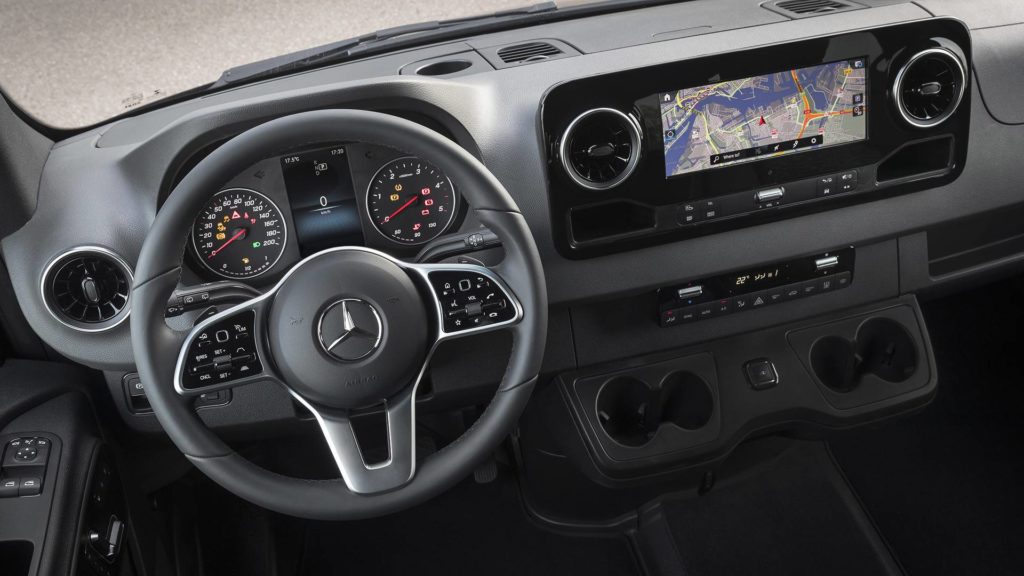
It feels silly to buy any new RV now that will come on a chassis that was designed in 2006 and which is about to be made obsolete – but most class B manufacturers are still waiting to get their hands on the 2019 Sprinter chassis and are not even taking orders for models based upon this yet.
Is it worth waiting for the new Sprinter, or trying to get our hands on one of the first of the new models to be made into an RV?
This isn’t an issue with the ProMaster or Ford, which are not on the verge of such a major refresh.
And of course – if we go used this isn’t really a consideration at all.
The Roadtrek / Hymer Scandal
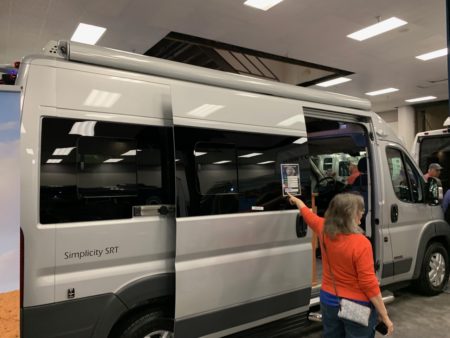
One of the long-time leaders in the Class B market has been Roadtrek, which was acquired in 2016 by Hymer – which also owns the Sunlight and Carado Class-B brands.
Hymer is now in the process of being acquired by RV giant Thor – leading many to worry just what the future might hold after so much transition. Thor doesn’t have the best reputation for overall quality, after all.
But just in the past few days – things seem to have come crashing down at Hymer North America and RoadTrek before the Thor acquisition deal was even completely closed.
There have been reports of layoffs, sudden executive firings, and allegations of up to $100 million of fraudulent invoices being discovered.
In other words – things are a mess, and forensic accounts are being called in to sort things out while the entire company potentially grinds to a halt.
Until things shake out – we are hesitant to get involved with even consider buying something new from any of the Hymer-related brands that are going through such turmoil.
At least not until any concerns about ongoing quality and support can be addressed.
So – What Next?
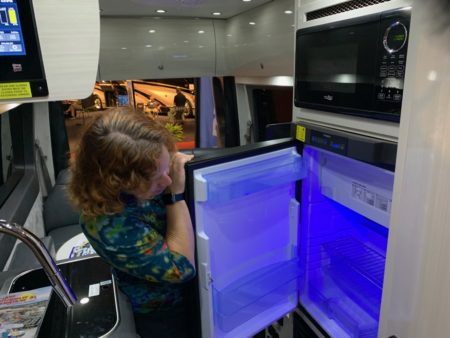
We are just now de-cloaking and revealing our secret plan to become part-time van dwellers – and now we need to track down our little shuttlecraft.
We are looking for advice and recommendations on additional options to consider, and leads on worthwhile used models for sale.
Or maybe we can be persuaded to go new.
For something we might only use a few weeks out of the year, it’s really hard to justify the cost of new. It would have to be something really special.
In the meantime, stay tuned for how our search evolves!

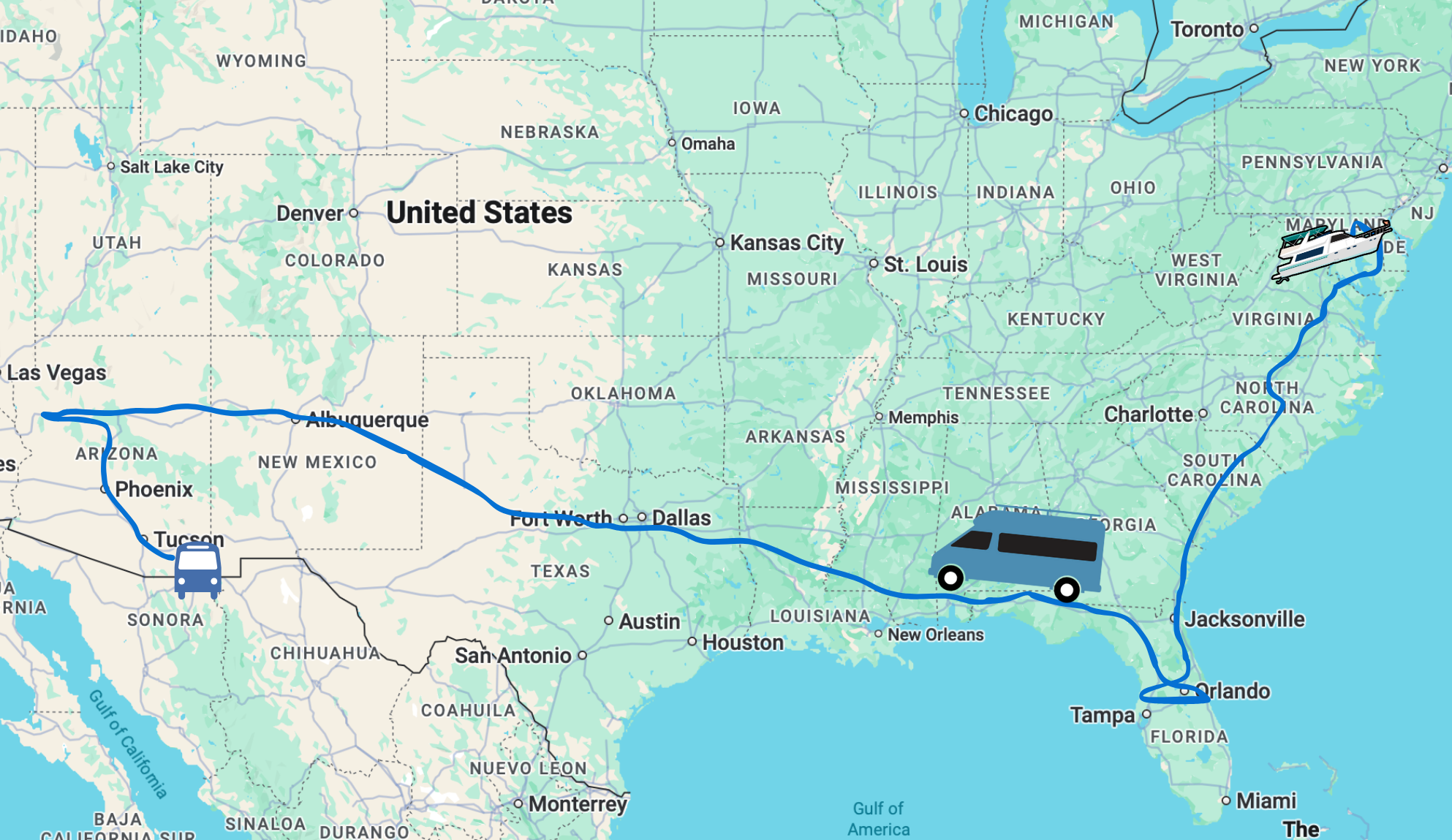
Thanks for this very informative and probably very close to comprehensive summary. We’re also cruising sailors and we just bought a used VW Rialta (21 feet, Winnebago outfitted), which has a full-time comfortable double bed, full galley and enclosed head. Our first outing in November to Shenandoah Park was great fun and we’re looking forward to longer, Western trips this coming year. Would you care to comment on the Rialta? –we’d appreciate your thoughts.
No experience with the Rialta, but we did borrow a Le’Sharo (the predecessor) before.. https://www.technomadia.com/2011/05/the-lesharo/
Good video. Wife & I (we’ll be 60 later this year) have looked at the Class B, B+, & small Class A. What I saw on both of your faces at the RV Show was sticker shock. We felt the same way. The Leisure Van Unity, is the cat’s meow. Model with the Murphy bed was my personal favorite. It had the best stuff (too long to list). But it cost more than our house. Good grief ! You can’t park it on the street or in a parking lot space, too long, at 25′-1″. What a shame !! Other similar units were not up to the standard of that unit. Anything smaller just doesn’t have the space needed for part-time living/traveling and the quality on the smaller units was, not worth owning. My opinion. Especially if it cost as much as my house. Good grief. Enough ranting. You guys keep us entertained and informed. Keep up the good work. If you go through Arkansas on I-40 give us a heads up (Van Buren/Fort Smith). We may be home or not ?? Meal at Neumeiers (BBQ) is on me. Safe travels.
Love your videos AND your lifestyle! Thank you for sharing them with us.
I’m a wannabee, and it’s such a help to see and hear the process of shopping from experienced RVers. The RV shows here in Atlanta have hardly any B or C vehicles, so I’m tagging along, looking over your shoulders!
Thanks for your videos; this is the first time I’ve hunted down the blog and tried to comment on one, though I’ve enjoyed several in the past, mostly coming from a boating background. I had some great times in a Pleasureway Plateau TS [2014] which is a bit longer than you want [22 or 23 ft including the spare tire hung out back] but the idea of it as a daily driver gives me cold sweats. I suspect you both are better drivers of large vehicles than I am, due to having Zephyr and all, but this sprinter-based class B was the largest thing I’d ever driven and boy was it difficult for me. Even on the highway, with the fancy countertop and all those nice cabinets up high its CG was too high and the miles were just never easy. I usually drive my truck [2000 tundra] at 75 when the road allows, but I had to slow down to 50mph in the sprinter in order to feel as comfortable as at 75 in the tundra. But no one wants to go anywhere at 50 so instead I was going 55 to 60 [and getting passed by trucks constantly] and I was still uncomfortable. It was like going 85 to 90 in the truck. Doable, but 100% attention required. NOT something I’d want for routine XC relocations. And at 23 ft my city parking options were quite limited. Even my 18 ft long Tundra I have to pull full up against whatever barrier there is so that my ass end isn’t sticking out into traffic in parking lots. I only dared park the sprinter in really large lots. Oh right, and about build quality… I was not super impressed. They used a non wet location rated gfci in the WET BATH, which died even without anyone ever taking a shower in there. Fortunately it failed safe, but it took a bit to trace down why none of the outlets worked, oh, hey they’re all chained off the GFCI in the bathroom… which won’t reset. And little annoying things, like they didn’t have a strainer/filter on the toilet flush water, so when the hot water tank scale backflowed into the cold water pipes, it clogged up the toilet flush/spray mechanism. Oh right and the check engine light came on midway through a trip and you only get 500 miles to get that resolved before the engine goes on a countdown to refusing to start. The high tech diesels at least at one point were really hard & expensive to figure out why they weren’t working. Maybe that’s gotten better by now, with time they might be able to fix the right thing the first time, but wow. Lots of growing pains. On the bright side someone will have figured many of these things out for you on a used rv! 🙂 But really, do a serious test drive, ideally both on highway and urban area, with a loaded vehicle, before ditching the mini! Good luck in your search, thanks again for the great videos!
We are quite happy with our Airstream but have friends seriously looking at Class B vans so we sent your post to them. They loved it and found it both extremely informative and well written. Thanks for all the work that went into it. It was really appreciated.
Very interested in following your approach to using a Class B as a toad for a much larger RV. We are approaching from the opposite direction. Already have the B. Now considering adding a larger RV, most likely an A, then a newer B, not necessarily in that sequence.
is it a requirement that your B be a new or newer model? If not, have you considered an Xplorer, such as an M-230 XLWT? For your B, recommend that you look at PW Lexor FL, which has a nice area for a workstation up front, nice tank sizes, but somewhat limited OCCC at just over 1,400 lb. The Winnebago 59G has much more OCCC at around 1,850 lb. (59GL around 250 lb. less OCCC), but with smaller tanks. Both the Lexor FL and the Winnebago 59G are on our short list for the B upgrade. Good luck in your search!
Good information – thanks for the comprehensive overview. Enjoy the exploration!
Thanks for the great comprehensive article – thinking about a van too and this is a great compilation
Hi–your post was passed to me by my wife, Pat Brunette. We own a 2001 Lazy Daze 30 ft. island bed model. Much too big for what you’re seeking, but they do make a 24 foot model. They are famous for rugged construction; Lazy Daze rigs have been known to survive accidents that would turn lesser RVs into kindling wood and scrap metal. If 24 ft. is still too big, here’s wishing you “good hunting” in finding something more compact that will do the job and keep on truckin’. http://www.lazydaze.com/
Lazy Daze has a stellar reputation, however they make Class-Cs, not Class-Bs. And yes, even their smallest is too big for this desire.
I was also at the Tampa show (on Friday) looking at all of the Class Bs – and then decided we’d probably upgrade our 23-foot Airstream to a 25-foot Airstream Globetrotter. But here are my van thoughts:
– Next time you check out a Promaster-based van, make sure that you can recline the driver’s seat far enough to be comfortable. Surprisingly, the factory recline adjustment seems very limited. Combine that with the telescope-only steering wheel, and the driving position feels cramped and overly upright.
– The nice thing about the Agile is that Pleasure-Way has been making them for years, so you could find a used one. Look for one on the “freshened” NCV3 Sprinter chassis (around MY2014 for the chassis; they have different headlights.) They added a lot of modern safety gear, like blind spot monitoring and forward collision warning. There was also a 2.1-liter diesel four-cylinder mated to a more modern 7-speed automatic. It appears that drivetrain has had fewer problems with its emissions system than the V6.
– The Transit is likely to get an interior upgrade for the next model year, which will also add a lot of the safety equipment found on the Sprinter.
– Every Safari Condo product I’ve toured has had very high quality and extremely happy owners. But the.process for US customers is long – you take a van to them to convert, and there is a yearlong backlog. The shorter vans also have an erect-as-you-need bathroom setup, which doesn’t sound like what you want.
I understand you plan to caravan and not tow four wheels down, but if you find any models of Sprinter or the Dodge or Ford versions that are similar that are towable four wheels down, please pass that information along in your search updates.
Davy
BTW, Advanced RV is building on the short Sprinter…saw a couple when I toured the factory…but I doubt it’s been long enough to find these in the used market.
We travel for months at a time in our non-extended Sprinter 3500 (Airstream Interstate). I wish it was a little shorter when driving in cities, but it’s the best choice for our needs.
We found that the bench seat wasn’t comfortable as a bed…which means you’ll need extra space to store a mattress topper. We finally ripped it out and built our own lengthwise twins which convert to a full bed. If I was starting again, I’d probably buy the twin option and add a platform on the floor to make sitting comfortable.
We had a 3rd party convert it to Lithium and extra solar, which has been wonderful.
We think the A/C is unbearably noisy, just replaced it with one of Advanced RV’s quiet A/C units. It made a world of difference!
So…if you can’t find exactly what you want, consider how you could upgrade it gradually over time. Smaller initial investment, and throw a few dollars at it as needed. I think this is what you’ve been doing with the boat, but van upgrades are much less of a hassle. For example, our lithium and solar upgrade took about a week, and the A/C upgrade took a day.
Good luck in your search!
Matt Carr at Carr Industries and Oregon Motor Coach, has been doing some creative specialty Class B conversations. It’s been two years since I’ve been to OMC, so have no idea how far he has gone with this. But if you would like to work with someone to build a Class B to your liking – he has a very talented staff at Oregon Motor Coach. (Some of the long time staff members, built Country Coaches back in the day.) And Matt’s a woodworker at heart, the creativity in the cabinetry I’ve seen produced, is top notch. So that’s one person you could check in on if you want to take the time for a special for you B. I’ll also share that some friends of ours spent two-three years searching for their Class B. They ended up with the Winnie Via. They had tried to stay shorter, but found that the 25P model gave them the bed they wanted, and the livability they wanted too. They’re adding Lifeblue’s to extend their battery capabilities. And so far, are very pleased with their decision… Best to luck to you on your search!!! Smitty
I watched your YouTube video about his subject. I was surprised you were on the hunt for a Van. It makes sense to me. We certainly understand needing a large enough vehicle to transport from one place to the other and a camper van makes perfect sense. Good luck in your search. p.s. I had trouble finding where to leave a comment.
Glad you found your way to the comments…
Glad to see your blog is again active. Like some others, I have been a lurker. Reading about your research to increase your “Fleet” will be interesting and fun. Regarding the never ending debate between gas & Diesel; contemporary gas engines, with things like direct injection, variable cam timing, turbocharging, etc., can narrow the mileage gap between the two engine types. Especially considering the additional cost of a diesel engine.
We figure any van that joins the fleet will get better fuel economy than the boat or bus 🙂
Great information, really well thought out and researched. Great comments. I must admit I’m sorry about the TV show and the new RV craze everywhere . It’s making full timing way harder to do and quiet places in nature way harder to find.